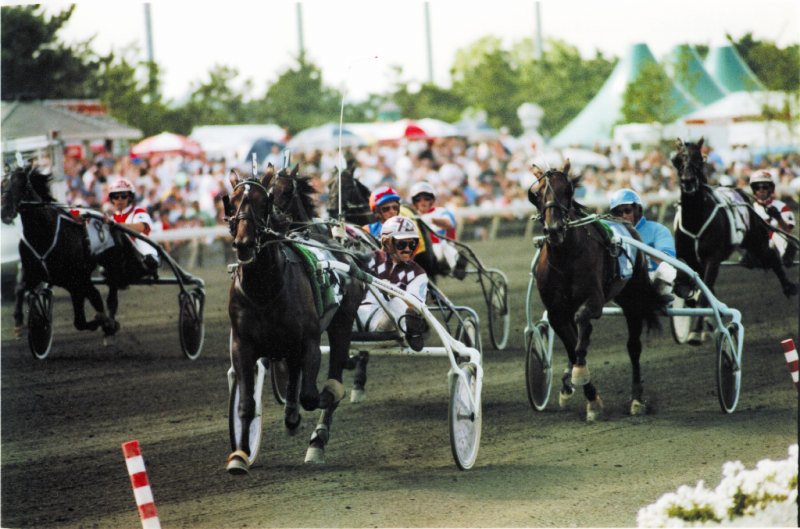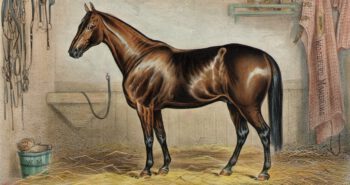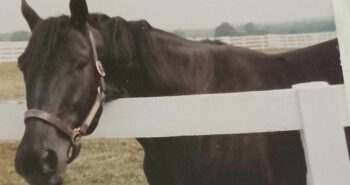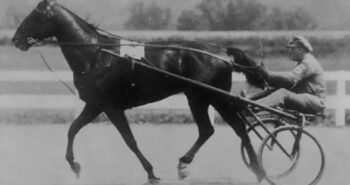He was the last superstar trotter bred by Yankeeland Farms, the legendary Maryland-based farm that closed its doors in 2006. Muscles Yankee commanded a high fee at the yearling auction in Lexington. However, the $200,000 shelled out turned out to be a massive bargain as the big colt developed into a legendary racehorse and stallion.
A son of Valley Victory out of Maiden Yankee, the colt was a looker and had a good pedigree, though with a slight question mark hanging over his dam, Maiden Yankee. She had been a good trotter, notching 13 wins, including the Lady Suffolk, though she was in the shadow of world record holder Fancy Crown (and Petrolianna usually had her number, too). Moreover, Maiden Yankee was also a full sister to the highly talented Defiant Yankee. The question mark was that her first six foals hadn’t been anything special. Yet, most buyers felt this one was different. In the end Chuck Sylvester had the highest bid on behalf of Jim Wheeler, but only a month later Perretti Farms bought a quarter share of the yearling. That, however, was a spur of the moment – or alcohol of the moment – thing:
“Life at Perretti Farms was somewhat unconventional and while we eventually owned the whole horse, we merely bought in for 25% at Harrisburg following an uproarious dinner with wine sessions with one of the colt’s purchasers, the inimitable Jim Wheeler. We never looked at Muscles Yankee in Kentucky and of course had no way of seeing him at Harrisburg as he may have been at Chuck Sylvester’s barn by then, but the two verbose dinner comrades – Wheeler and Bill Peretti – worked it out and we owned 25 %”, Bob Marks wrote in a column at DRF Harness.
Muscles Yankee started his racing life on Aug 1, 1997, when he trotted 2:05.2 in a qualifier with John D Campbell in the sulky. Ideally, Sylvester would have liked to get going earlier, but surgery prevented that.
“I remember that when we got him he had OCDs taken out of his hocks…and when we x-rayed him, he still had OCDs in his hocks. So he had to be operated on again. So he got a late start because of that,” recalled Sylvester in an interview on the USTA website.
Good news and bad news
After another qualifier, Muscles Yankee made his regular racing debut on August 19, 1997 at Rosecroft, driven by Mike Lachance, the only time in a regular race that Campbell didn’t drive him, and finished second to Fuji.
Just two weeks later he showed his massive talent when he won the Champlain Stakes at Woodbine in 1:58.2 (1.13,5). That’s when both Marks and Campbell really took notice.
“I interrupted Bill Perretti’s Labor Day cookout announcing I had good news and bad news. When he stopped yelling, he asked for the bad news first, which was that Mr. Sylvester had neglected to tell us the colt was racing in Canada. The good news was that Muscles Yankee had set a season’s record winning the Champlain Stake and suddenly we owned 25% of what could be a valuable stakes colt,” recalls Marks in his column.
Muscles Yankee won five of the remaining seven races that year, only failing to be victorious in the biggest races… He won The Standardbred, Bluegrass Stakes, International Stallion Stakes and his elimination heats to both the Breeders Crown and the Valley Victory Stakes. In both finals he was the clear favorite, but broke stride and finished out of the money each time. The breaks were down to the track being too hard on his feet on both occasions. Sylvester described him as “good gaited even though he had a dish foot in his right front. We always had to worry and work on that. But he was a very smart and very good horse. I knew that with the way he was built that he’d be a good sire. He was a good-sized Valley Victory, and never touched his boots or anything. He never had a bad training day. He was always a horse that was ready to do his work and it came easy to him. He never had any problems. He was a horse that always wanted to please you.”
During his 2-year-old season Wheeler sold a quarter to Herb and Irv Liverman and another quarter to David French. At the end of the year he sold his last quarter to Peretti who then owned half of the trotter. As Bob Marks later pointed out in an interview with Hoof Beats , “While we’re always looking for the best available, we didn’t buy into Muscles Yankee thinking he was anything more than a promising trotting colt that we’d enjoy racing in partnership with Jimmy Wheeler, a charming rogue who we’d become friendly with at Harrisburg. We had a great sale that year, and it was more of an impulse than anything else. We had never even seen the colt. We said, ‘We’ll take 25 percent of the trotter.’ We didn’t know who he was. We never looked at him. We weren’t even on the program, but after his 2-year-old year, when it was obvious that he was going to be next year’s Hambletonian favorite to us, anyway the opportunity came to buy another 25 percent because Wheeler was in financial doldrums. Bill’s entrepreneurial instincts took over. He saw it as an economic bargain for us.”
After 9 starts at two, Muscles Yankee had earned $166,327 and was considered one of the Hambletonian contenders. Campbell had seen enough to be very impressed.
“Chuck Sylvester and I talked at the end of the season and I told him it’s a really good horse, he just had work on his manners during the winter. When he came back Muscles Yankee was a real professional. Sylvester taught him how to behave and how to relax. He had some issues with a food that Chuck had to deal with, but he was a perfect horse to drive.”
“He just took off”
Muscles Yankee returned to the track at 3 with an easy win at the Big M. Then, after losing a heat of the Historic Dickerson Cup at the Big M to Kick Tail, Muscles Yankee won six straight including elimination and final of Beacon Course and Hambletonian, Yonkers Trot and Transylvania Trot. Ahead of the Hambletonian, Sylvester adjusted the equipment slightly, putting on a Norwegian bridle. This change certainly helped cement the superiority of the Valley Victory-son.
“He was perfect that day. I knew he was the best horse, but he was sensational. In the final stretch, he just took off. He was a horse that could really get in high gear very quickly. Since he would relax when he should and never wasted any energy, he immediately got in high great when you asked him to go,” says Campbell.
Chasing the Triple Crown
After winning the Yonkers Trot, Sylvester and Campbell set their sight on Muscles Yankee becoming the first Triple Crown winner since Super Bowl in 1972. Most of his rivals started in the World Trotting Derby the week after the Yonkers Trot, but Sylvester opted out of the race at DuQuoin. Some people criticized the trainer for this, but he had his sights firmly set on the Kentucky Futurity, the third race in the Triple Crown. It could be that a reputation subconsciously played a role; the Valley Victory get were generally thought to be extremely talented, but somewhat short-lived, and that they should be started selectively to get the most of out them. The reputation – or myth? – was based on the fact that most of his best foals made 20-some starts and didn’t have long careers. It is quite possible, though impossible to know, that this was in the back of Sylvester’s mind as he didn’t want to start his star in the two-heat, possibly three-heat, World Trotting Derby – which in his absence was won by Kick Tail in straight heats.
For all the focus on the Kentucky Futurity, though, the Triple Crown dreams died in the last turn at the Red Mile. Despite looking in good form just the weekend prior (when winning the Transylvania Trot), he had a bad day when it mattered and finished 5-3 in the two heats. In the first heat he faded after dueling with Mastery and Kick Tail. In a qualifier at Garden State Park two weeks later he was looking fairly good, but a veterinary check found a small issue and he was treated in knees.
Bouncing back
In the Breeders Crown elimination he easily defeated Kick Tail and ahead of the final, which would be the final race of his career, Campbell decided to change the tactics a bit. Usually he would launch an attack and get to the lead before or around the halfway point, then pull away down the final stretch, but in the Breeders Crown final Campbell played his cards a bit more patiently. Attacking in the last turn, he was even with Conway Hall at the top of the long final stretch at Colonial Downs. Coming home he gradually pulled away, easily defeating Conway Hall by two lengths in 1:53 (1.10,2).
He retired after the Breeders Crown win, and even though he had 15 wins in 21 starts his trainer felt the horse could have gotten even better in future seasons. “I would have liked to have seen him come back as a 4-year-old because I think he would have been bigger and stronger. But the economics of him going to stud didn’t allow for that, and I certainly understand it. I think he would have proven himself even more so on the track had he had another year,” Sylvester explained in an article on USTA’s home page.
An immense legacy
Muscles Yankee retired to stud at Peretti Farms where he serviced 177 mares in 1999. That was only that start of a stellar stallion career. Muscles Yankee immediately proved himself and produced top trotters all over the world throughout his time at stud. Most famous is of course Muscle Hill, one of three Hambletonian-winners (Deweycheatumnhowe and Muscle Massive are the other two), and he sired 12 dollar-millionaires in North America. In Mr Muscleman, Muscle Hill and Deweycheatumnhowe he sired three $3 million trotters. However, Muscles Yankee has produced stars all over the trotting world. Down under, his son I Can Doosit is one of the best horses of all times in the Southern Hemisphere.
In Finland he sired the exceptional mare Target Hoss, winner of the 2008 Finnish Kriterium and 2009 Finnish Derby. Over in Sweden he has produced Dileva Käll, winner of the Swedish Mare Championship in 2011 and 2013. In Norway he sired Muscles Wiking BR, winner of the 2011 Norwegian Derby and the 2010 European Championship for 3-year-olds. Another son in Norway is the exceptionally fast world champion Ferrari BR, whose 1.09,9 (1:52.2f) over 2100 meter (1 5/16 mile) set a spectacular world record for 4-year-olds back in 2017.
Muscles Yankee also excelled as a broodmare sire, one example being the international stars Ecurie D and Aetos Kronos, others being Creatine, Lucky Chucky, Explosive Matter.
We asked Campbell for his observations of Muscles Yankee, Muscle Hill and the Valley Victory-line:
“Muscles Yankee and Muscle Hill were very similar in gait and demeanor on the track as neither unnecessarily wasted any energy in the race. Muscle Hill was a lot athletic built horse than Muscles Yankee, he was another generation than athletic. Muscle Hill just took Muscles Yankee’s speed and athleticism to a different level. Ecurie D is more excitable than Muscles Yankee, but both had tremendous speed and gait. The way Mack Lobell moved behind was two or three generations ahead, but he did trot higher in front than horses of today. The difference in the gait came from Valley Victory, who made horses more efficient-gaited as a sire then any other stallion. Valley Victory and his get trotted lower in front with no wasted motion.”
Muscles Yankee was inducted into the Harness Racing Hall of Fame in 2009. The legendary colt died peacefully in his paddock at Peretti Farm on May 9, 2020.
muscles yankee
Bay colt born in Frederick, MD on Apr 9, 1995. Died in Cream Ridge, NJ on May 9, 2020.
Valley Victory – Maiden Yankee (Speedy Crown)
21 starts: 15-2-1 – 3, 1:52.2 (1.09,9) – $1,424,938
Breeder: Yankeeland Farm
Owners: Yankeeland Farm – David French, Irving Liverman and James R. Wheeler – David French, Irving Liverman and Perretti Farms
Trainer: Chuck Sylvester
Drivers: John Campbell, Luc Ouellette (only qualifier), Michel Lachance and Troy Sylvester (only qualifier)
Groom: Bonnie Richards





